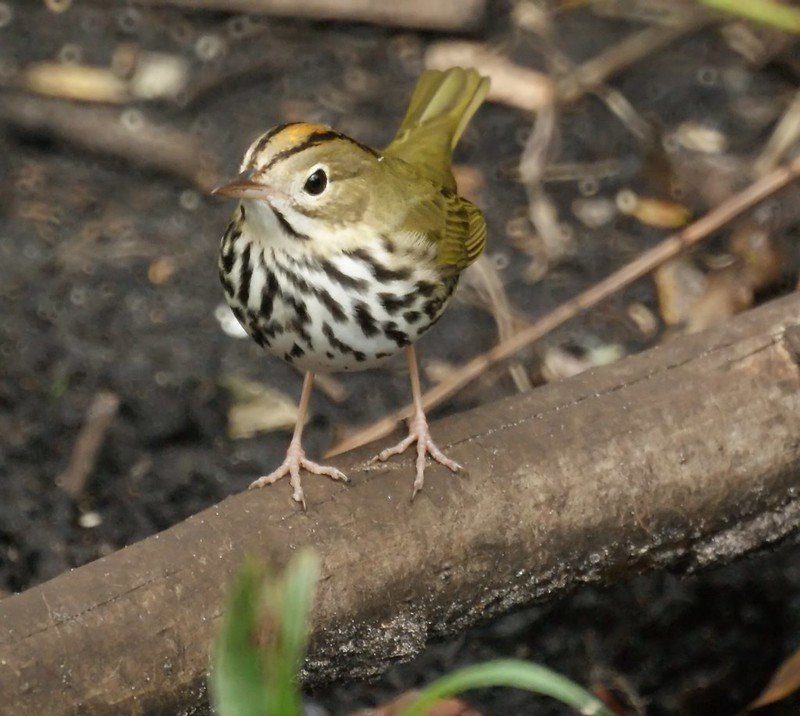July Nature Almanac: Ovenbirds Fill Foothills Canyons with Exotic Song
Stephen Jones and Ruth Carol Cushman
July 2024
"Tea-CHURR, Tea-CHURR, Tea-CHURR..." The sweet, insistent song resonated through the pine forests of upper Gregory Canyon as we led a Teen Naturalist group on a breeding bird and butterfly count. The song drew us like a magnet, as if a mysterious and exotic visitor had suddenly materialized among us.
This wasn't the first Ovenbird we'd encountered this spring and early summer. We heard five singing in shady canyons on Eldorado Mountain in early June, two singing in upper Shanahan Canyon, and two more singing among greening maples and box elders in Bear Canyon. That's more than the total number we heard singing anywhere in Boulder County from 1970 to 2010.
Ovenbirds may not look like other wood-warblers and shouldn’t be confused with South American ovenbirds. Photo by Mike’s Birds CCBY-SA
For years these secretive wood warblers, so familiar to inhabitants of the Appalachian Mountains and Southern Canada, had been considered rare in Colorado. And the bulk of the observations occurred in canyons south of Colorado Springs, where leaves from native oaks, interwoven with grass, stems, and hair, provided material for construction of the warblers' oven-shaped ground nests.
Beginning about 15 years ago, we began to hear Ovenbirds singing in most of our moist foothills canyons containing ponderosa pine and Rocky Mountain maple. What brought them here, and could the maple leaves be providing a suitable substitute for oak leaves in their nests?
The only rub is that we've yet to receive a report of an occupied Ovenbird nest anywhere in Boulder County. These relatively drab warblers, with pale orange crowns and rows of dark brown spots on their white breasts, are notorious for being secretive nesters.
The females require about 5 days to weave together the dead leaves, grass, bark, and other materials, and during that time they remain alert to any potential predator who might be watching. After all, a ground nest on the forest floor can represent a meal invitation to a weasel, raccoon, squirrel, snake, or owl. The female Ovenbird compensates for nest vulnerability by covering the finished nest with leaf litter and creating only a tiny hole in the side of the nest for entrance and egress.
Ovenbirds have been reported nesting in pine-oak woodlands along a narrow strip of the Front Range foothills since the early 20th century, with documented nesting sites occurring far to the north and east in Wyoming, South Dakota and Nebraska. From 2007-13, Colorado Breeding Bird Atlas fieldworkers found singing Ovenbirds in just 13 of 1800 sampled locations throughout the state. This year we've received reports of singing Ovenbirds from a half dozen canyons in the Boulder Mountain Parks alone. What has prompted this Ovenbird explosion?
It's not likely global warming, since our disjunct Ovenbird population lies at the southwestern extreme of the birds' North American breeding range. However, other factors have contributed to a visible change in the nature of vegetation in our foothills canyons. Areas that were once mostly treeless and dry are now filled with lush growth of Rocky Mountain maple, box elder, crack willow, chokecherry, and other shrubs. At the same time, our native ponderosa pines have matured, creating a shadier and more protective forest environment.
Much of this dramatic change likely results from removal of grazing cattle from the lower foothills along with absence of periodic fires that would scour out the undergrowth. In these micro-habitats, our actions have created an inviting but hardly natural landscape that reminds some observers of Appalachia--or perhaps Central Park.
Is this a good or a bad thing? For our part, we appreciate the outburst of Ovenbird song within our greening foothills canyons while mourning the disappearance of some local birds who require arid shrublands and grasslands for nesting. But perhaps most of all, we celebrate the ability of birds to adapt to environmental change while filling our lives with sweet music.
Other Events in July and August
Female Dusky Grouse photographed in Long Canyon, Boulder County. Photo by Chris Petrizzo.
Dusky Grouse mothers lead their half-grown young through shady foothills forests.
Golden Eagle young fledge from giant stick nests in the Flatirons and other Cliff nests throughout Boulder County.
Monarch butterflies sip nectar from milkweeds growing in the South Boulder Creek State Natural Area. Adults lay their eggs on the milkweed plants, and the next generation will undertake the 1500-mile migration to Mexico in September.
Thunderstorm activity typically peaks from July 15-August 25 as monsoon moisture flows up from the Gulf of Mexico, prompting a renewed wildflower bloom in late summer.
Monarch adult on narrow-leafed milkweed. Photo by Steve Jones.



